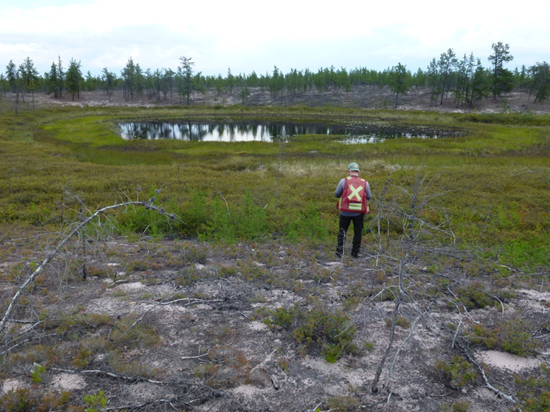VANCOUVER — Global diamond miner De Beers may have walked away from CanAlaska Uranium’s (TSXV: CVV; US-OTC: CVVUF) West Athabasca diamond project in Saskatchewan, but CanAlaska president and CEO Peter Dasler still believes the property’s geological and geophysical puzzles are worth solving.
On Dec. 23, De Beers returned 100% of the project to CanAlaska after drilling seven shallow targets, saying that a magnetic organic layer found at or near surface could explain all the “kimberlite-like” geophysical anomalies on the 174 sq. km property.
Dasler told The Northern Miner during a phone interview in January that while some anomalies are explained by the presence of organics, reprocessed magnetic survey data indicates that others require their combination with one or more, deep-rooted magnetic bodies.
The newly modelled magnetic bodies are shaped like kimberlite pipes or dikes, according to the latest geophysical report from Ontario-based consultant group Scott Hogg and Associates.
“There are a large number of targets that can’t be explained by this type of magnetic material at surface. Even if you have a thick interval of this layer, you still have to compensate the magnetic response of the anomaly with something else at depth,” Dasler said. “It’s a puzzle. Why is it magnetic material there? … And what else is causing the magnetic response?”
CanAlaska began assembling a land package in the northwestern part of Saskatchewan’s uranium-rich Athabasca basin in February 2016, after identifying 75 circular-shaped, magnetic highs suspected to be kimberlites in a 800-metre spaced airborne magnetic survey. The survey was completed by the Saskatchewan Geological Survey in 2011.

CanAlaska Uranium’s West Athabasca kimberlite project, showing anomalies in red, in northwest Saskatchewan. Credit: CanAlaska Uranium.
The anomalies caught the attention of De Beers, and by May, it had committed to exploration expenses of up to $20.4 million over seven years to drill the targets in exchange for a 90% stake in the property.
But as exploration work proceeded, the results fell short of expectations.
De Beers wasn’t able to identify any kimberlite-indicator minerals in the 100 gravel samples collected from eskers within the target area — which Dasler says was due to sample quality being poor.
Then, after flying high-resolution magnetic surveys at a 50-metre line spacing, De Beers found that the 75 targets, each ranging up to 800 metres in diameter, were clusters of much smaller anomalies between 50 and 100 metres in diameter.
“What we ended up with were over 300 magnetic targets rather than 75 … which isn’t always a good thing. You don’t want a lot of small kimberlites, you’d rather have a large one,” Dasler said. “But it’s quite fascinating how they’re distributed. They’re in clusters, they seem to be on structures and they look interesting when you model them in geophysics.”
When drilling finished in October 2016, De Beers had found a black, greasy, and magnetic organic layer up to 20 metres thick in five of the seven drill holes. One of the other drill holes found a thin diabase sill, and all of the holes finished in sandstone.
By December, De Beers had ended its agreement with CanAlaska.
“We were surprised to get the project back, we really thought that drilling would be carried out this winter,” Dasler said. “There was a lot of rain and the water levels were high over the summer, and they weren’t able to access many of the planned drill sites. What they ended up drilling was not the selection that should’ve been drilled, so we figured they’d continue on when access improved.”
He commented that the organic layer was “highly unusual” and samples of it had been sent for analysis. A company press release points to scientific papers that describe bacterial production of magnetic material under certain conditions.
Additional studies by the Saskatchewan Geological Survey on 400-metre spaced magnetic data in northwestern Athabasca found that drumlins — an elongated, teardrop-shaped mound of boulder clay formed by glaciation — are a “significant hindrance” to the interpretation of magnetic maps in the area because they can generate circular-shaped anomalies.
Dasler and CanAlaska vice-president of exploration Karl Schimann said in an email that the anomalies on CanAlaska’s West Athabasca property are not consistent with drumlins, or caused by any changes in topography.
“Out of 300-plus targets we still believe there are a significant number of targets that should be drilled for kimberlite. It’s a matter of finding the ones that are large enough to potentially be economic,” Dasler said. “I’m pleased we got this preliminary work done … we’ll benefit from the significant assessment credits to the property over the next few years, and that’ll give us time to puzzle through the question.
“We believe there’s excellent potential to find diamonds in the Athabasca. It’s underlain by a thick part of the Rae craton, which contains the Diavik and Ekati mines … there are major structural features cutting through the crust, and north of Fort McMurray, down-ice from us, there are kimberlite-indicator minerals,” Dasler said.


Be the first to comment on "CanAlaska not giving up on diamond hunt in West Athabasca"